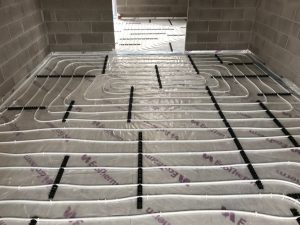 Heat pumps usually deliver heat in the form of hot water, as do most conventional central-heating systems. However, to maintain a high energy-efficiency, the emitter system (the means of providing heat within the building) should be designed so that the water temperature is as low as possible. As the water is at a low temperature, you need a larger surface area to emit the heat.
Heat pumps usually deliver heat in the form of hot water, as do most conventional central-heating systems. However, to maintain a high energy-efficiency, the emitter system (the means of providing heat within the building) should be designed so that the water temperature is as low as possible. As the water is at a low temperature, you need a larger surface area to emit the heat.
Ideally, a well-designed underfloor heating system should be used, designed specifically for use with a heat pump with plenty of pipe and high flow-rates. This is slightly different from using underfloor heating with a conventional boiler since heat pumps have a different design emphasis. A mixing valve to drop the temperature for the floor pipes should not be used. Underfloor heating systems are energy efficient and very comfortable.
Radiators are an alternative to underfloor heating but the radiator area needs to be significantly larger in area than normal (possibly twice the size), because the radiators are operating at a lower temperature. Several radiators in one room could be considered.
Ducted hot air is an alternative method of distributing heat into a building; however, this is often not as comfortable as radiant (underfloor) heating and should be installed with caution. It is particularly undesirable in badly insulated buildings.
Heat pumps are less forgiving of the design details compared to boilers, so designs and installations must be carried out carefully.
Because heat pump systems operate at lower temperatures, they are better suited to well-insulated buildings.
